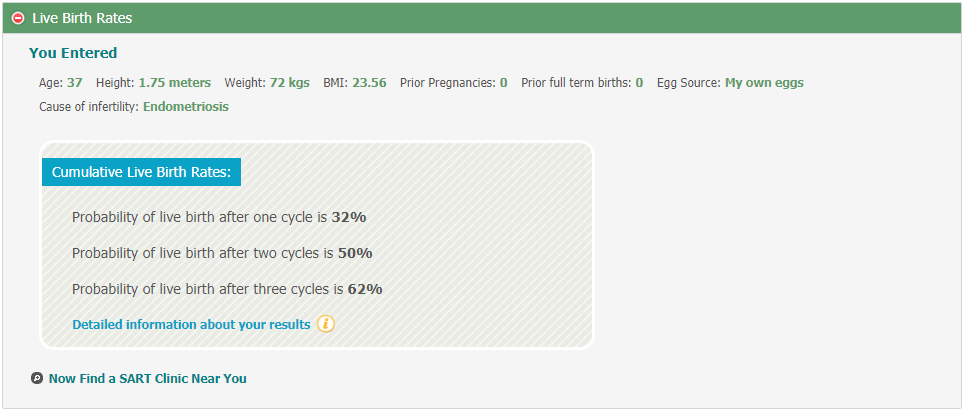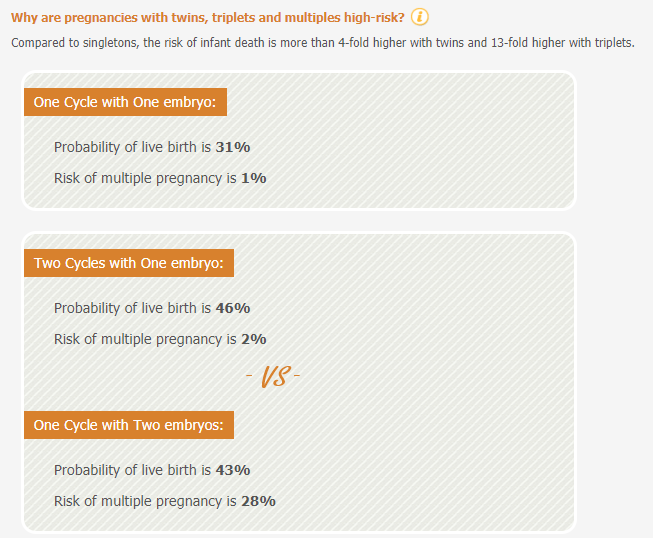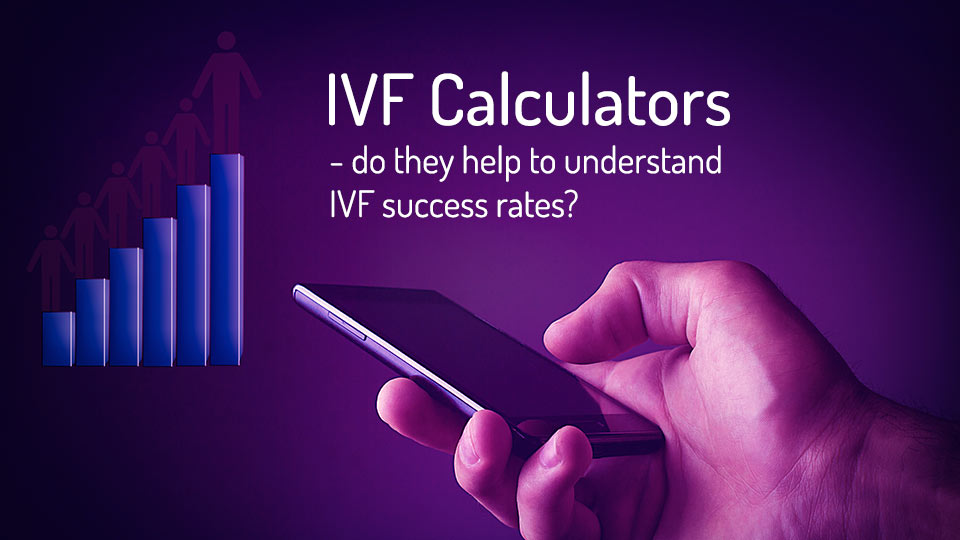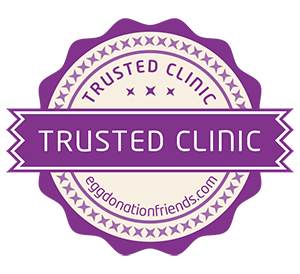Last updated: 5 June 2025
IVF Calculators – do they help to understand IVF success rates? – Summary
- What IVF Calculators Do: IVF calculators provide estimated success rates based on individual inputs like age, fertility history, and treatment type.
- Personalized Insight: These tools offer a customized view, helping users understand realistic expectations rather than relying on broad averages.
- Limitations of the Tools: Most calculators rely on population data and do not factor in individual medical specifics like egg quality, male factor issues, or uterine health.
- Clinics May Use Them Differently: Some clinics offer calculators on their websites, but they may reflect clinic-specific data, which could be optimistic or outdated.
- Not a Replacement for Medical Advice: While useful for education, IVF calculators should be viewed as a guide only, not a substitute for personalized consultation with a specialist.
- Empowering Patients: When used correctly, these tools can empower patients, helping them ask better questions and set realistic emotional expectations.
IVF calculator – can I check what chance I have to get pregnant after IVF?
When talking about the chance of pregnancy, we mean IVF treatment statistics. Consider for a moment what kind of statistics would be the best from the patient’s point of view.
Of course, the percentage of live births per IVF cycle started and of course in connection with the woman’s age. Ideally, such statistics should be presented taking into account the causes of infertility of the patient, that is, a separate statistic for each of the causes of infertility.
In this case, you can probably estimate in which group you are and what your stats are in terms of your chances of getting pregnant, and at best, the birth of a child.
Of course, it is worth asking the clinic in which you are going to be treated, about their experiences and successes in treating patients similar to you – at least in terms of age, causes of infertility, and medical history. Not many clinics can answer such a question. Usually, statistics will be based only on the age of the woman.
It’s also important to understand the difference between IVF with own eggs and IVF with donor eggs success rates. There are more factors in “IVF own cycle” influencing the outcome than in egg donation programmes. However, the most critical is to know what pitfalls can await patients who base their decision to choose a clinic on statistics that are presented on the IVF clinic website.
That’s why we published a comprehensive guide to IVF with donor egg success rates where you will find everything “clinics don’t want to tell you”. We also have a special guide to IVF success rates published as requested by our patients. You should also be aware of cumulative IVF success rates as there are more and more clinics presenting data in this way – which may be misleading for patients.
Nevertheless, we have good news for you! There are many online prediction tools for IVF that help calculate your chances of pregnancy after IVF, and actually, or even better, of giving birth to a child after IVF. Each of them is based on different data and methodologies. You should remember that these are statistical methods and should only be treated as a guide.
Is an IVF success rate calculator worth using?
Definitely, these calculators are worth looking at. As a patient one of the most important pieces of information that helps you identify the most appropriate treatment provider is its IVF success rate. You probably already know that most clinics limit information about treatment success rates to the so-called pregnancy rates, therefore a clinical pregnancy (usually 6-8 weeks) per embryo transfer. In the case of statistical models, you will receive information about real opportunities not for pregnancy but for the birth of a child. Actually, what percentage of patients who were in a similar medical situation to you ended IVF treatment successfully?
Using online statistical models, you can verify how much – statistically – the clinic deviates in its presentation from tools that operate on very large data – at least 100,000 IVF cycles. Remember that the size of the data on which the statistics are based is of key importance. In short, the more data about IVF cycles, the more accurate the statistics and the closest to the truth. Why is that? Imagine the situation in which the IVF clinic gives you statistics for selected IVF parameters and it equals 50%. The question is, what was the size of the sample on which it was calculated? What if the clinic had 10 such patients and 5 became pregnant? With each subsequent patient, such statistics – up to a certain point (of a given sample size) can change significantly both down and up. That is why the appropriate group on which the statistics are prepared is so important.
IVF calculators – let’s test them out
IVF Success Estimator – CDC (SART PREDICTOR)
This is a great IVF success predictor for patients where you can estimate the likelihood of getting pregnant and giving birth to a child. This IVF rate calculator also shows the cumulative success rate for 2 and 3 IVF cycles.
Furthermore, you will also find information about the risk of getting pregnant with a multiple pregnancy. Predictor was developed by SART (Society for Assisted Reproductive Technology) in the US based on approximately 500,000 IVF cycles, which since 2006, were taken by over 320,000 women, based on data from over 80% of IVF Clinics in the US. With such a large statistical group the results will certainly be close to reality. IVF clinics in the US offer very good quality of therapy, high success rates and access to modern therapeutic methods.
This is what SART writes about its model:
“While more models are coming soon, this model includes sequential transfers of fresh embryos only, no frozen transfers. ”
What is worth noting in contrast to other models is that SART PREDICTOR takes into account BMI (BMI may be of significant importance in the treatment of infertility), which is calculated automatically based on height and weight.
Website: https://www.cdc.gov/art/ivf-success-estimator/
or: https://w3.abdn.ac.uk/clsm/SARTIVF/
IVFPREDICT
IVFPREDICT seems a more complicated online prediction tool than the SART PREDICTOR, but the information we obtain as a result is limited to information about the statistical chance of giving birth to a child with the help of IVF.
An interesting fact here is the use/inclusion in the methodology of a group of stimulation drugs to choose from (Gonadothropin/Antiestrogen/Hormone replacement) and information whether the ICSI procedure will be performed.
The model has been developed based on over 140,000 cycles performed in the UK. The model was prepared by Prof. Scott Nelson – University of Glasgow, Prof. Debbie Lawlor – Bristol University and Dr. Tom Kelsey – University of Saint Andrews.
Website: http://www.ivfpredict.com/index-1.html
OPIS IVF PREDICTOR
Another IVF success calculator that allows you to check your chances is OPIS (Outcome Prediction In Subfertility).
This IVF calculator is built differently than the previous two because, in the first place, patients must choose whether they had IVF before or whether they are interested in the statistics of the subsequent IVF cycles. OPIS was based on HFEA data from the UK involving IVF cycles in 1999 – 2009.
We did not find information on how many cycles the statistical model implemented by the University of Aberdeen works. However, looking at the age range, it is certainly more than 100,000 IVF cycles. In this model, the causes of infertility are limited to a few options (unexplained fertility/problem with tubes/male factor). The number of parameters to enter also seems quite poor compared to previous tools. As a result, we get a graph that shows the average effectiveness (live birth) in 6 IVF cycles per cycle.
Website: https://w3.abdn.ac.uk/clsm/opis/home/toolintro
Testing IVF calculators & prediction models
In each tool, we tried to choose similar parameters in the patient’s medical history:
- Woman’s age: 37 years old,
- no IVF treatment in the past
- no past pregnancy
- attempt duration 2 years,
- cause of infertility – endometriosis
- of course, the IVF program with own eggs.
We received different results as the prediction of the success rate (we have to emphasize that OPIS PREDICTOR did not include an option for selecting infertility causes).
SART PREDICTOR – IVF success results
With this tool, we received very detailed data on the expected treatment success rate. In addition to the standard calculation of one IVF cycle, we receive information on the 2nd and 3rd cycles of IVF and the IVF success rate, and the risk of multiple pregnancies depending on the number of transferred embryos.
- The probability of live birth after one cycle is 32%
- The probability of live birth after two cycles is 50%
- The probability of live birth after three cycles is 62%

One Cycle with One Embryo:
- The probability of live birth is 31%
- The risk of multiple pregnancy is 1%
Two Cycles with One Embryo:
- The probability of live birth is 46%
- The risk of multiple pregnancy is 2%
One Cycle with Two Embryos:
- The probability of live birth is 43%
- The risk of multiple pregnancies is 28%

IVFPredict – IVF success results
The only information that IVFPredict provides is:
“Your chance of a live birth per IVF attempt is 28.5%”

OPIS – IVF success results
The only information provided by OPIS was:
“Your chance of having your first baby after 1 complete cycle of treatment is 36.96%.”

Conclusion
As you can see, the results of individual tools and the amount of received information differ significantly.
In our opinion, SART PREDICTOR is a tool that every patient should start when joining the IVF programme regardless of whether it is the first IVF cycle or the next. The tool offers you great possibilities when it comes to input parameters. As a result, you get very accurate data, which will certainly be useful for you.
Using this type of tool can also help you plan your treatment budget. It is easier to realistically plan the costs when you know how statistically your chances of having a live birth look after the first IVF cycle and, for example, after 3 cycles.
There are more online tools that can estimate the chances of IVF pregnancies, but the above three have very strong scientific support supported by research and scientific publications. What is important, they use data collected on the basis of at least 100,000 IVF cycles of patients and in the case of SART PREDICTOR approximately 500,000 IVF cycles.
While IVF success predictors offer valuable information, they’re not a substitute for personalized medical advice. Trust your healthcare team’s expertise and stay committed to your journey. Your path to parenthood is unique.
If you know an online tool that is used to estimate the chances of IVF pregnancies which is not on our list but you think it should be included, contact us and we can consider whether to include it in the future.
If you need help choosing an IVF Clinic abroad, spare 3 minutes of your time. You will save at least a few hours.
If you are looking for an egg donation clinic abroad, use the eggdonationfriends unique patients tool – Clinic Matching Test. Our consultants will analyse your needs and choose 3 overseas clinics which match your expectations. Our database of IVF centres includes only trusted fertility clinics which have experience in providing high quality services to international patients. The suggested IVF centres will contact you directly within 3 working days. Spare 3 minutes of your time – you will save at least a few hours! Our assistance is free of charge.
Article sources:
- https://www.cdc.gov/art/ivf-success-estimator/
- https://w3.abdn.ac.uk/clsm/SARTIVF/
- https://doi.org/10.1371/journal.pmed.1000386
- https://www.bmj.com/content/355/bmj.i5735
- https://doi.org/10.1093/humrep/dew069
- https://sartcorsonline.com/Predictor/PatientV2Landing
- https://w3.abdn.ac.uk/clsm/opis/home/toolintro
Table of Contents







